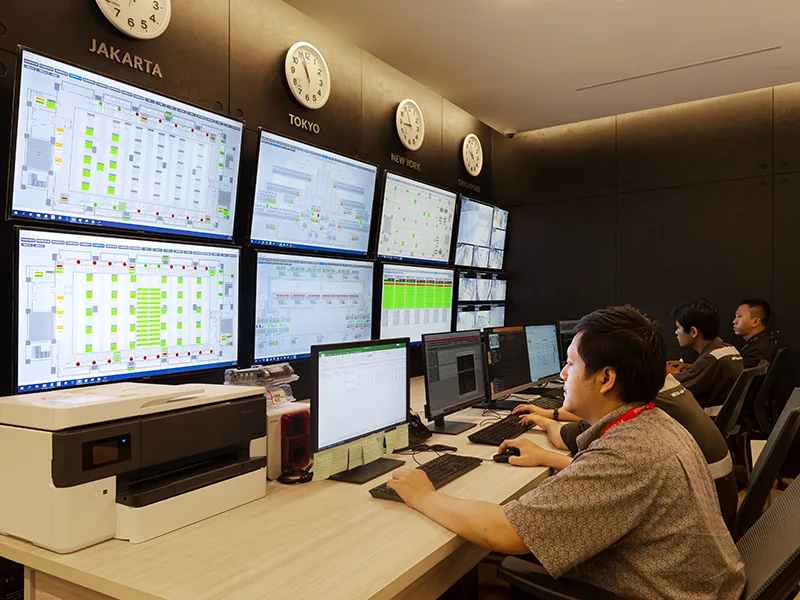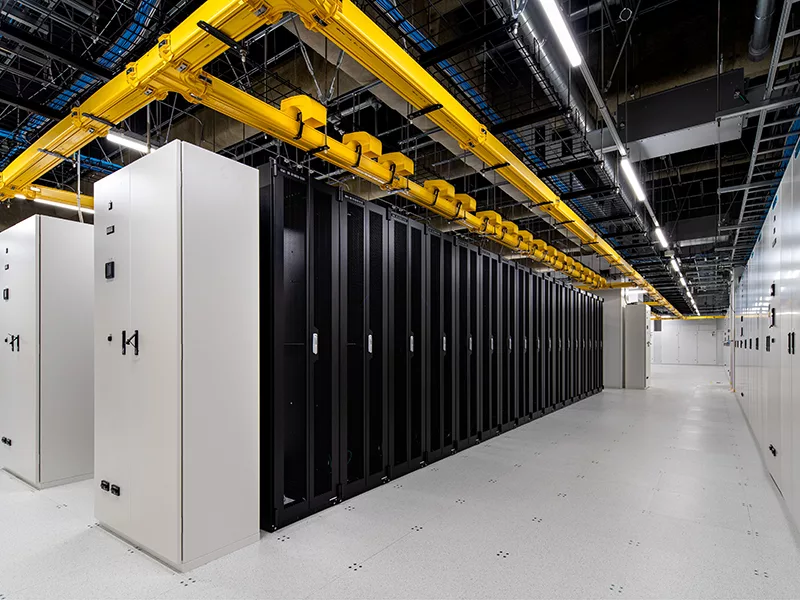As one of Asia’s fastest growing data centre platforms with a reputation for constructing and operating state-of-the-art, energy-efficient data centres rich with connectivity options, Samuel Lee, CEO of Digital Edge DC, shares how the company has made a name for itself by building a robust, sustainable digital future.
BUILDING THE FOUNDATION FOR ASIA’S DIGITAL FUTURE
Digital Edge DC (Digital Edge) has been on a mission since its inception to bridge the digital divide and bring world class infrastructure to Asia Pacific (APAC).
Established at the outset of the global COVID-19 pandemic, the rapid acceleration of digital services across the region in recent years has opened doors for new players like Digital Edge. By designing, developing, and operating advanced, energy-efficient hyperscale and enterprise data centres with abundant connectivity options across APAC, the company aims to enable the ongoing digital transformation of businesses across the region.
“Having been established in 2020, we are currently in our fifth year of operation,” introduces Samuel Lee, CEO.
“We aim to build a data centre platform across APAC by not only covering the big Tier 1 markets like Japan and South Korea but also looking at new locations such as the Philippines and Indonesia.”
Currently boasting a total of 17 data centres operating across six different markets, Digital Edge has experienced rapid growth over the course of the past few years, making headway by working with major hyperscale and cloud providers to expand their capabilities within the region while also supporting the deployment of fast-growing artificial intelligence (AI) applications.
In Lee’s view, constructing a data centre platform is not merely about building a collection of individual facilities, but creating an integrated platform with consistent standards and seamless service across the region.
“If a customer likes our services provided in Japan, they can anticipate the same processes in South Korea or the Philippines, for example,” expands Lee.
“That’s why we call it a platform. It’s about creating a consistent customer experience across our product and service offering.”
Despite the complexity of the region with contrasting business practices, cultures, and regulations, Digital Edge aims to make it easy for companies to expand their digital footprint throughout APAC. For example, by signing a master agreement with Digital Edge, customers can expect the same quality and standards regardless of which Digital Edge data centre they deploy into.
“We pride ourselves on saving our customers time and making things more predictable for them,” details Lee.

BRIDGING THE DIGITAL DIVIDE
With over 25 years of experience in the IT and telecommunications (telecoms) industry, Lee is recognised as a data centre transformation and growth leader with a proven track record of building and running data centre companies throughout the APAC region.
After serving as President of Equinix Asia-Pacific, where he grew the company to be the market leader in all of its operating countries while increasing annual revenues from USD$40 million to more than USD$1 billion, he embarked upon a new venture – founding Digital Edge with several other industry stalwarts.
“When we established the company, data centres were not a new thing in Asia,” explains Lee.
“There were already some big players and friendly competitors from other parts of the world present in well-established locations in the APAC region, specifically in mature markets such as Japan, Hong Kong, and Singapore.”
Therefore, Digital Edge sought to differentiate itself by also investing in emerging markets, including India, Indonesia, and the Philippines, where Lee and the other founders saw significant headroom for growth.
“We believe people, enterprises, and service providers in these markets deserve to enjoy the same level of infrastructure as those in Japan or South Korea,” he comments.
Lee is excited about the future of this dynamic industry, especially with the exponential growth being predicted for digital services and the supporting infrastructure.
“Currently, data centre is a buzzword around the world, not just in APAC. When you look at North America, Europe, and even Africa, people are talking about data centres, as they are the most critical infrastructure for the modern digital economy,” he notes.
The explosion of the internet and digital services within the region is a key demand driver for the data centre industry, creating a plethora of new markets that are ripe for growth.
With abundant capital and plenty of talent, the region is attracting the world’s leading cloud and technology companies who are looking for opportunities to further expand their infrastructure.
“APAC is truly getting the best of both worlds. We have an influx of international companies, alongside Asia-based hyperscalers with a global appetite,” excites Lee.

UNLEASHING THE POWER OF AI
Digital Edge has also had to respond to the rapid rise of AI and the impact this has on data centre design and services. As such, the company is adapting to future-proof its facilities and ensure it can cater to the demands of this rapidly evolving technology.
“People expect that AI will change the world,” declares Lee.
“We, like everyone else, recognise that it will enhance productivity and provide people with an unparalleled edge.”
Echoing the world-altering introduction of personal computers, the internet, smartphones, and the cloud, AI is the fifth technological shift that will ultimately create immeasurable demand for the data centre industry across a variety of sectors.
However, it is important to acknowledge that in the context of the technology field, AI is still very new, even for companies specialising in its services.
“Everyone is still in the learning cycle, and, of course, there will inevitably be change alongside trial and error. Therefore, it is necessary to embrace these next few years with an open and flexible mindset,” expands Lee.
AI-enabled data centres are on a significantly larger scale than ever seen before, demanding more power alongside enhanced liquid cooling capabilities, presenting new challenges for operators around how to build facilities big and fast enough, as well as managing sizeable capital deployments in the right place and at the right time.
Digital Edge not only recognises these potential hurdles but is prepared to tackle them head on, building sizeable campuses such as its planned 300 megawatt (MW) site in Navi Mumbai, as well as pioneering innovative liquid cooling solutions.
Additionally, the company is in the process of deploying AI from a different perspective to enhance its own operations.
“We can use both AI and robotics to maintain our data centres and serve our customers. Computers and robots can also be used to eliminate human errors and provide around-the-clock reliability,” details Lee.
Digital Edge is working to utilise these new technologies to analyse data within its facilities to create efficiencies and even drive predictive maintenance, leveraging real time data to identify and act on issues before they escalate.
It is clear the future of AI presents significant opportunities for the industry, however, it is still a very nascent technology. Naturally, it will take time for companies to learn how to deploy AI on a sustainable level.
“Unlike what you see in the movies, you cannot just turn AI off and on again and expect it to work. You need to educate it, train it, and set up rules and parameters, all of which take time.
“I would say deploying AI is a journey; it’s not a matter of if but when, as I think everyone will eventually use it. We are still in the early stages of the process, but we’re incredibly optimistic that AI will provide us with an advantage as a business,” enthuses Lee.

EMBRACING LOCAL STRENGTHS
Digital Edge is built and propelled by a diverse global team that understands the markets in which its customers are present and where they ultimately want to expand to. Crucially, the business works with local partners and utilises a localised supply chain across its platform.
A focus on localisation is crucial to ensuring a smooth transition when expanding across APAC, as it helps solve difficulties in navigating diverse currencies, languages, local customs, and regulations, which can make growth a challenge for those not readily familiar with individual markets.
“It’s hard for us and our customers to really understand all the APAC markets and be an expert in the region’s many cultures and business practices,” insights Lee.
“Working with a local partner helps us accurately navigate the various processes. To build a data centre you need to buy land, apply for government approval, and obtain sources of power and water, all of which are steps that change depending on the location. Hence, having a local partner to understand how to get things done swiftly and correctly is one of the key ingredients for success.”
This collaborative success with local partners can be directly observed through Digital Edge’s recently opened data centres in Jakarta and Manila, alongside its upcoming facility in Seoul scheduled to open in autumn 2024, where the company has worked alongside leading local companies with a proven track record in their fields.
The locations for these new build sites were carefully selected to cater to fast growing demand for digital infrastructure in the region, both in more mature markets as well as the emerging economies in Southeast Asia.
“To put it simply, there’s a lot of demand in these geographies, and our customers have directly asked us to go there,” expands Lee.
“We are targeting hyperscale and AI customers, and together, we are engaging in a learning process about the future of the industry. With the growth in both AI and cloud in these locations, we are confident in the future of these markets.”
In terms of the technology provided in these new data centres, as noted earlier, Digital Edge applies the same standards across its entire platform to ensure consistency in the customer experience and product offering, while adapting the design to best suit local nuances, including differing climates which can impact data centre operations.

“Currently, data centre is a buzzword around the world, not JUST in APAC. When you look at North America, Europe, and even Africa, people are talking about data centres as they are the most critical infrastructure for the modern digital economy”
Samuel Lee, CEO, Digital Edge DC

INFUSING DIGITALISATION WITH SUSTAINABILITY
As the demand for digital resources continues to grow exponentially, Digital Edge recognises the need to build the foundation for the world’s digital future in a way that is sustainable in the long term.
That is why the company’s environmental, social, and governance (ESG) goals reflect its respect for the resources used, the people and communities served, and the transparency in the way its business is operated.
With an aim to lead the field by setting global standards for the industry and using data-driven insights to track progress and ensure the company is held to account every step of the way, Digital Edge is committed to maintaining consistently high standards of business ethics.
“ESG is important to us because we value being a responsible public citizen. We, of course, want to make a profit, but at the same time we don’t want to do so at the expense of the planet and its people,” dictates Lee.
“Equally, it is also mandated that our investors and customers partake in these sustainable practices.”

Currently, Digital Edge is prioritising power and water efficiency for its data centres as the two areas which make the greatest impact on its sustainability goals.
Beyond the environmental standpoint, optimising power and water efficiency also benefit the company’s bottom line, including helping to reduce utility bills across the platform – one of the most significant big-ticket items in a data centre’s cost structure.
From every perspective, Digital Edge, its investors, and its customers are motivated to achieve impactful and meaningful ESG results.
“Around the globe, many people are discussing how data centres are the biggest consumers of power and energy. So, if we do not assume responsibility for making ourselves green and efficient, we are going to see unwanted damage done to the world.”
These attributes are ingrained within the company’s DNA, having continually proven itself in recent years to be a champion of building greener data centres. This includes becoming the first colocation operator in the region to pioneer innovative StatePoint Liquid Cooling technology from Nortek, enabling its new facilities in Manila and Jakarta to achieve market leading energy efficiency metrics.

CUTTING-EDGE CONNECTIVITY
Providing an enhanced and efficient connectivity offering is crucial to nurturing a thriving digital ecosystem within a data centre and attracting customers.
“A data centre without connectivity is basically an uninhabitable island, meaning that no one is willing to go there,” states Lee.
With the primary purpose of the industry being to help customers store, analyse, process, and send data to their target audiences, the ability to transport data through ‘peering’ and interconnection is of the utmost importance.
“Not only do we offer connectivity to our customers, but we believe it’s very important to provide them with a choice. Therefore, we offer them as many connectivity options as they can enjoy,” asserts Lee.
Digital Edge’s ‘carrier-neutral’ data centres mean that each facility is open to working with multiple different telecoms carriers. This model makes it easy and seamless for customers in various sectors, such as cloud, AI, or enterprise, to choose from a multitude of network providers.
“Our customers are given the opportunity to shop around. They have options readily available in order to enable them to choose the best offer in the marketplace, helping drive down costs and achieve utmost efficiency.”
“Not only do we offer connectivity to our customers, but we believe it’s very important to provide them with a choice. Therefore, we offer them as many connectivity options as they can enjoy”
Samuel Lee, CEO, Digital Edge DC

EMBARKING ON A DATA-DRIVEN FUTURE
Owing to its belief that cutting-edge technology should be made accessible, and through the initiatives of the company’s global leadership team, Digital Edge continues to build enterprise and hyperscale data centres in the underserved markets across APAC, bringing performance, proximity, and data sovereignty everywhere it is needed.
As the company continues to look towards the future, its priorities consist of completing its three data centres currently under construction ahead of schedule and within budget.
Additionally, Digital Edge is working alongside its customers to better understand how AI will evolve, including looking to expand into new sites that can cater to these high-power density deployments.
“In the digital world, I always say that no one has a crystal ball. However, we believe that AI will become huge and hit the globe more rapidly than any previous technological advancement,” confides Lee.
“This will have a long-lasting impact on the data centre industry, and you can expect people to begin building bigger facilities with a lot more power and cooling infrastructure.”
Whilst anticipating the global influence of AI, Digital Edge has witnessed more of its customers moving to remote locations in order to acquire cheaper power and land prices.
“Countries which used to be unattractive are becoming much more appealing, especially when they provide tax benefits like a free trade zone,” further insights Lee.
“We expect some of the emerging markets to expand very quickly and that technology will also change at a rapid pace in the upcoming years as a result of the rising demand for AI.”
While these changes are occurring swiftly and having an immense impact on the entirety of the global industry, Digital Edge is ready to be a leader in this digital future, ensuring that digital infrastructure deployment across APAC is easy, efficient, economical, and sustainable for its customers.





























